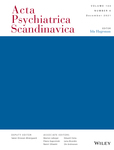Frequency and types of emotional dysregulation in referrals to child and adolescent mental health services
Abstract
Introduction
Emotional dysregulation (ED) is a transdiagnostic phenomenon that has received increased attention, because of its potential ability to explain the development and maintenance of various psychiatric disorders. The identification of ED may serve as a potential target for both preventive and treatment interventions, however, the frequency of transdiagnostic ED among children and adolescents has not previously been evaluated. Our aim was to evaluate the frequency and types of ED in accepted and rejected referrals to the Child and Adolescent Mental Health Center (CAMHC), Mental Health Services, Copenhagen, Denmark, regardless of psychiatric status and across diagnoses. We aimed to evaluate how often ED would be a leading cause in seeking professional help, and whether children with ED not directly reflecting symptoms of known psychopathology would have higher rejection rates than children with more distinct symptoms of psychopathology. Finally, we assessed associations between sex and age with various types of ED.
Methods
We examined ED in a retrospective chart review of referrals of children and adolescents aged 3–17 years to the CAMHC between August 1st, 2020, and August 1st, 2021. We ranked problems described in the referral as primary, secondary, and tertiary depending on severity. Further, we examined group differences in the frequency of ED in accepted versus rejected referrals, as well as group differences in types of ED in age and sex distributions, and diagnoses occurring with specific types of ED.
Results
ED was present in 62.3% of the 999 referrals and was assessed as the primary issue in twice as many rejected referrals (11.4%) compared to accepted referrals (5.7%). Boys were significantly more often described with externalizing and internalizing behavior (55.5% vs. 31.6%; 35.1% vs. 26.5%) as well as incongruent affect (10.0% vs. 4.7%), whereas girls were more often described with depressed mood (47.5% vs. 38.0%) and self-harm (23.8% vs. 9.4%). The frequency of different types of ED varied with age.
Conclusion
The present study is the first to evaluate the frequency of ED in children and adolescents referred to mental health services. The study offers insights into the high frequency of ED and the associations between ED and subsequent diagnoses, which may prove to be a method of early identification of risk of psychopathology. Our findings suggest that ED may rightly be considered a transdiagnostic factor, independent of specific psychiatric disorders, and that an ED-centered as opposed to diagnosis-specific approach to assessment, prevention, and treatment could target transversal symptoms of psychopathology in a more holistic manner.

 求助内容:
求助内容: 应助结果提醒方式:
应助结果提醒方式:


